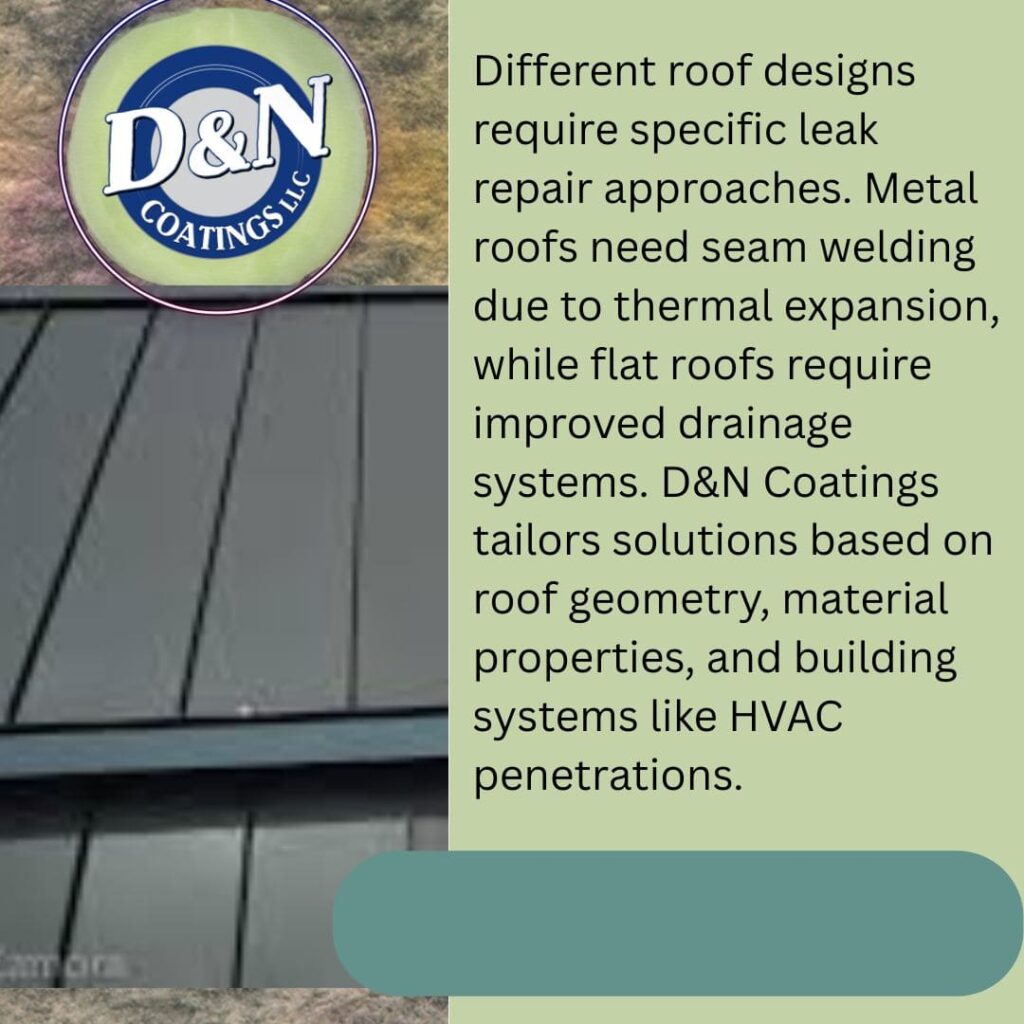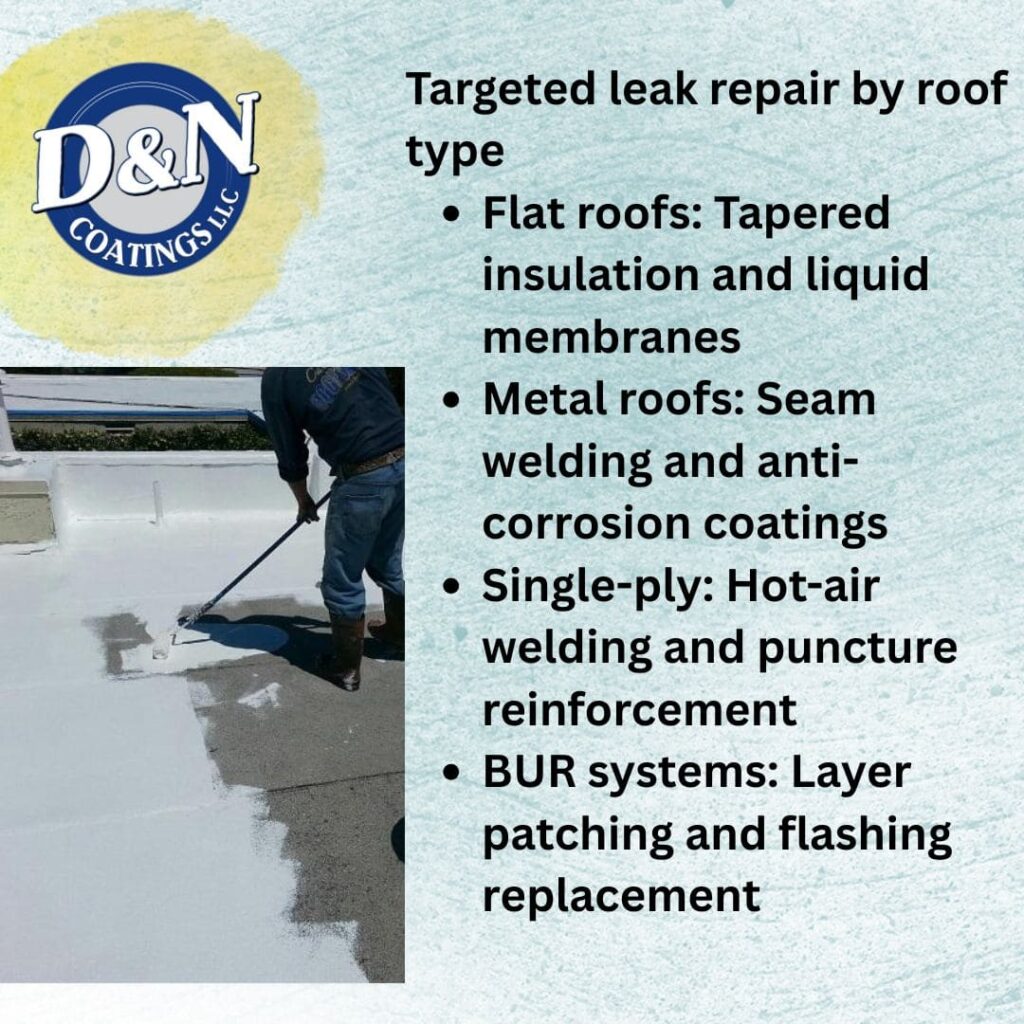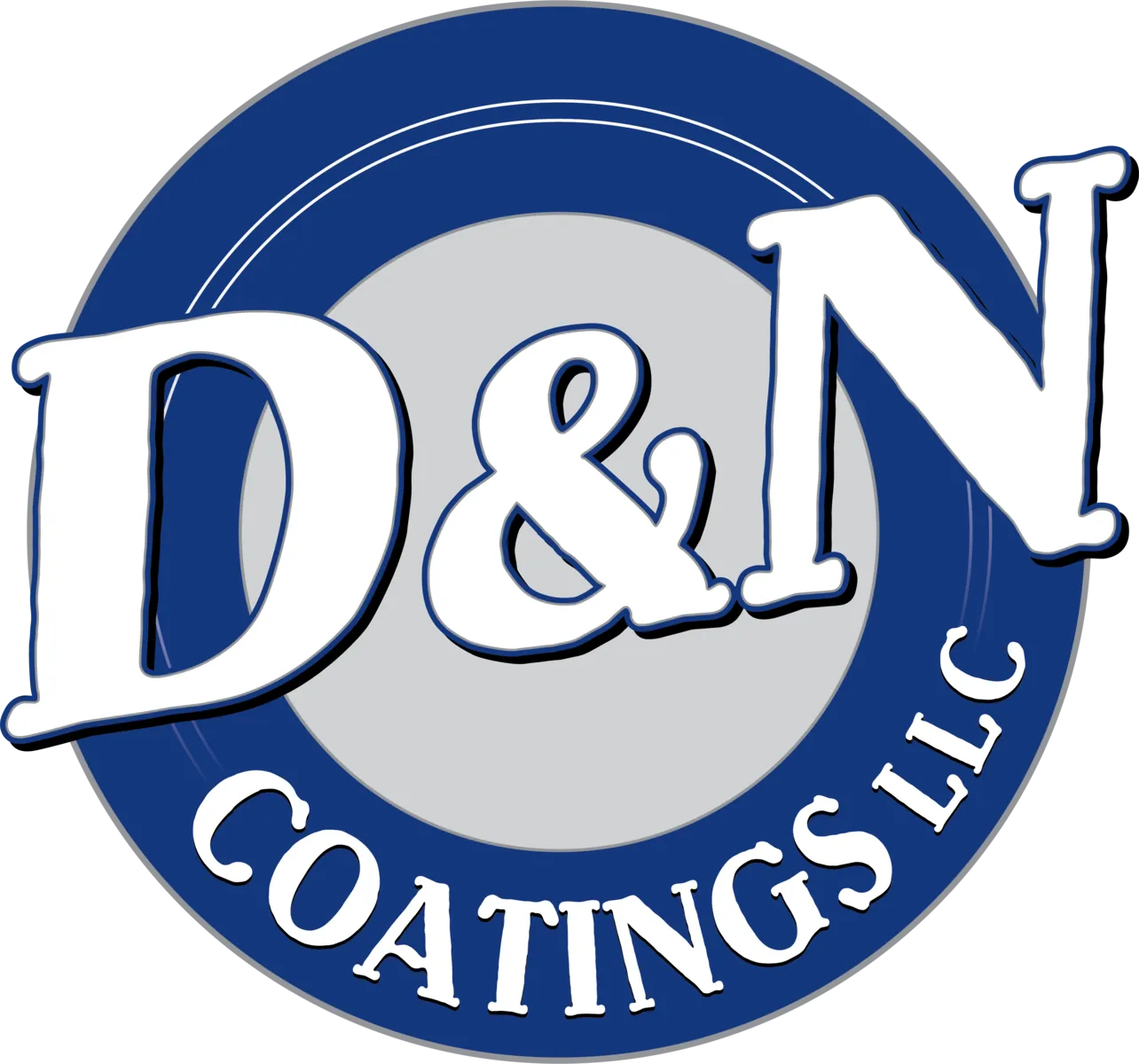D&N Coatings helps you address commercial roof leaks quickly and effectively. A small leak can lead to water damage, mold growth, and disruption to your business. That’s why we focus on leak repair solutions tailored to your property’s specific needs.
Your roof’s design plays a major role in how leaks occur and how they should be repaired. Flat roofs, metal roofs, single-ply membranes, and built-up roofing systems each have unique vulnerabilities. We apply commercial roof leak repair methods for each type, using proven techniques and high-quality materials. By working with us, you can protect your building, prevent costly damage, and maintain a durable roof for years to come.
Why Roof Design Determines Repair Approach
The design of a commercial roof plays a major role in how leaks develop and the repair methods needed. Each type of roof presents unique challenges that influence how roof leak repair is carried out.
Understanding Roof Geometry
The pitch, slope, and curvature of a roof determine how water moves across its surface and where leaks are most likely to form. Flat or low-slope roofs tend to hold water, which can increase pressure on the roofing surface and create weak points.
Steeper roofs allow water to run off quickly, but areas like valleys or intersections can concentrate stress and become common locations for leaks.
Material-Specific Considerations
Different materials respond uniquely to stress, weather, and age. Metal roofing can expand, contract, or corrode, while asphalt shingles may crack or lift over time. Single-ply membranes may experience seam separation, and built-up roofing systems require attention to layered materials. Applying effective roof leak repair techniques based on the material provides long-lasting protection.
Integration with Building Systems
Rooftop equipment, HVAC units, and solar panels affect the repair strategy. Penetrations and attachments create potential weak points where roof leaks can occur. Repair methods need to accommodate these systems while maintaining the integrity of the roof surface, allowing for both protection and functionality.

Common Leak Locations
Leaks tend to appear in specific areas depending on the type of commercial roof you have. Knowing where water is most likely to penetrate allows for precise repair and prevents further damage to the building structure. Each roof design presents unique vulnerabilities, and repair strategies must adapt accordingly.
Flat Roofs
Drains, parapets, and membrane seams are primary vulnerability points. Flat roofs often experience standing water because they lack the natural slope that directs runoff. Drains can become blocked or fail, causing water to pool on the surface. Parapet walls at the roof’s edges may trap moisture, which can gradually seep into the building.
Membrane seams are also common weak points, particularly where materials join. Addressing these areas early reduces the risk of structural damage and prevents water from affecting insulation or interior spaces.
Sloped or Pitched Roofs
Valleys, ridgelines, and eaves are prone to water intrusion. On pitched roofs, valleys where two slopes meet direct water downward, creating high-pressure zones that can wear away roofing materials.
Ridge lines at the top of the roof may experience weathering from wind and rain, and eaves at the edges are exposed to continuous water runoff. Targeting these locations helps preserve the integrity of the roof and reduces long-term maintenance costs.
Metal Roofs
Panel seams, fasteners, and edge flashings are frequent leak sources. Metal expands and contracts with temperature changes, which can loosen screws or create small gaps along seams.
Edge flashings, where the roof meets walls or other structures, are also vulnerable to water penetration. Timely repair at these points prevents corrosion and prolongs the roof’s lifespan.
Single-Ply Membranes and BUR
Membrane wrinkles, lap seams, and layer junctions require targeted inspection. Single-ply membranes can develop punctures or separation at seams, while built-up roofing systems involve multiple layers, where moisture may enter if any layer fails.
Careful inspection of these critical points allows commercial roof leak repair to focus on the sections most likely to fail, reducing the chance of recurring leaks and protecting the building over time.
Understanding common leak locations across roof types helps guide repairs and improve long-term roof performance. By addressing the areas most prone to water intrusion, building owners can maintain a reliable roof and minimize costly repairs.
Innovative Techniques Tailored to Each Roof Type
Each commercial roof design presents unique challenges, which influence how leaks are repaired. Using the right techniques for a specific roof type helps protect the building’s structure over time.
Flat Roof Leak Solutions
Tapered insulation, improved drainage design, and liquid-applied membranes help control water movement on flat roofs. Flat roofs are vulnerable to water pooling, which can weaken the roofing surface and increase the risk of leaks. Installing tapered insulation helps direct water toward drains, while adjusting drainage points reduces standing water.
Liquid-applied membranes provide a seamless protective layer over seams and vulnerable areas, making repair more efficient and long-lasting. This combination of strategies helps prevent recurring issues and maintains a strong roof surface.
Metal Roof Leak Solutions
Seam welding, metal patching, and anti-corrosion coatings are key methods for maintaining metal roofs. Metal roofs expand and contract with temperature changes, which can loosen fasteners or create small gaps.
Seam welding reinforces joints, metal patching addresses punctures or damaged panels, and protective coatings reduce the risk of rust and corrosion. Applying these methods addresses both visible damage and potential weak points, extending the roof’s durability.
Single-Ply Membrane Repairs
Hot-air welding, seam tapes, and puncture reinforcement help restore the integrity of single-ply membranes. Single-ply membranes can develop tears or separation at seams over time.
Hot-air welding fuses layers, seam tapes seal critical joints, and reinforcement materials strengthen areas prone to punctures. These approaches provide effective roof leak repair that restores the membrane’s integrity and prevents further water intrusion.
BUR Roof Repairs
Layer-by-layer patching, flashing upgrades, and waterproof coating applications are effective for restoring built-up roofing systems. Built-up roofing systems have multiple layers, and leaks often occur at layer junctions or around flashing.
Repairing each layer carefully, reinforcing flashings, and applying waterproof coatings make sure that the roof is protected. These techniques make roof leak repair precise, reducing the chance of future leaks and maintaining the system’s performance over time.
Using techniques specific to each roof type helps address leaks efficiently while protecting the building’s long-term performance. By targeting repairs where they are most needed, property owners can reduce damage, improve durability, and maintain a reliable roof for years.
Preventive Measures for Long-Term Roof Health
Maintaining your commercial roof proactively helps reduce damage and costly repairs over time. Implementing preventive measures allows you to detect issues early and address them with targeted solutions before they escalate.
Routine Inspections and Maintenance Plans
Scheduled checks reduce emergency repairs. Regular roof inspections help identify minor issues, such as worn seams, loose fasteners, or small punctures, before they develop into serious leaks.
Establishing a maintenance plan keeps the roof in good condition and reduces the need for sudden, extensive roof leak restoration work. By monitoring the roof consistently, you can preserve its integrity and extend its lifespan.
Leak Detection Technologies
Infrared scans, moisture meters, and thermal imaging identify hidden leaks. These technologies allow you to detect water intrusion that isn’t visible on the surface. Early detection through such tools helps direct repair to the exact locations where water is entering, minimizing damage to the roofing system and the interior of the building.
Proactive Flashing and Sealant Upgrades
Strengthening vulnerable points before damage occurs. Flashings and sealants protect roof edges, joints, and penetrations, which are often the initial places where leaks develop. By upgrading these components proactively, you can reduce the chances of leaks forming and maintain the roof’s durability. Regular attention to these critical points makes repair more manageable and less frequent over the life of the roof.

Trusted Commercial Roof Leak Repairs
D&N Coatings, based in Hartville, MO, provides dependable solutions for commercial roof leaks across Central and Southwest Missouri. You can rely on us to address leaks quickly, protect your building, and keep your roof performing over the long term. Taking action promptly helps prevent damage to roofing materials, insulation, and your interior spaces.
Local Expertise
D&N Coatings uses the knowledge of local weather and building codes to guide every repair. Missouri’s climate brings heavy rainfall, ice, and seasonal temperature changes that affect your roof. By considering these conditions, we can carry out repair that tackles vulnerabilities before they worsen, while making sure all work complies with local regulations.
Skilled Team
Our team applies specialized techniques for each type of roof to maintain its durability. Every roof has its own weak points. Flat roofs may collect water, metal roofs expand and contract, single-ply membranes can separate at seams, and built-up roofing (BUR) systems need careful attention to layers. By tailoring our methods to your roof’s design, we deliver effective roof leak repair that restores protection and extends its life.
Clear Process
D&N Coatings follows a structured approach to keep every repair organized, transparent, and long-lasting. We start with a thorough inspection to identify both visible and hidden issues. Then we provide a detailed proposal showing the scope of work, materials, and costs. After completing the repair, our team performs a final review backed by warranty. This process makes leak repair reliable and consistent.
Long-Term Performance
We focus on preventive measures and follow-up to keep your roof strong over time. Beyond fixing leaks, we check vulnerable areas and perform routine follow-ups to reduce recurring issues. These actions also support energy efficiency and reinforce key points to lower the risk of future water intrusion.
By combining local knowledge, tailored techniques, and a structured process, D&N Coatings delivers reliable commercial roof leak repair for every project. This approach keeps your building secure and lowers the risk of future damage. Our approach focuses on protecting your property while maintaining long-term roof performance.
Protect Your Roof Today!
Don’t let a minor leak turn into a costly problem. Reach out to D&N Coatings at (417) 241-3653 for reliable leak repair services. Our team provides thorough assessments, tailored solutions, and long-lasting repairs to keep your building safe and dry. Take action now and safeguard your roof with professional care you can rely on.

